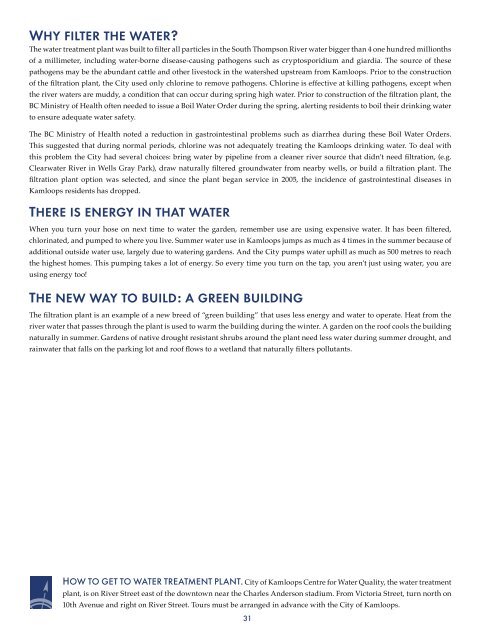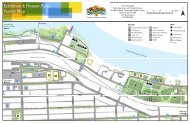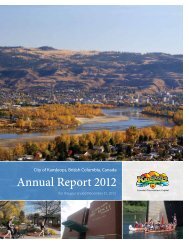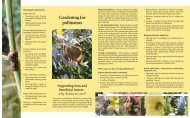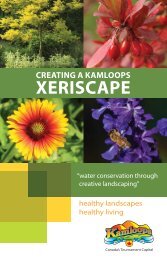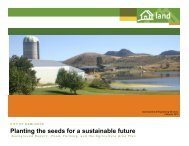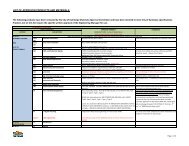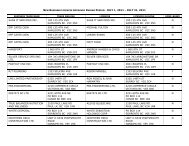GEOTOUR GUIDE - City of Kamloops
GEOTOUR GUIDE - City of Kamloops
GEOTOUR GUIDE - City of Kamloops
Create successful ePaper yourself
Turn your PDF publications into a flip-book with our unique Google optimized e-Paper software.
Why filTer The WaTer?<br />
The water treatment plant was built to filter all particles in the South Thompson River water bigger than 4 one hundred millionths<br />
<strong>of</strong> a millimeter, including water-borne disease-causing pathogens such as cryptosporidium and giardia. The source <strong>of</strong> these<br />
pathogens may be the abundant cattle and other livestock in the watershed upstream from <strong>Kamloops</strong>. Prior to the construction<br />
<strong>of</strong> the filtration plant, the <strong>City</strong> used only chlorine to remove pathogens. Chlorine is effective at killing pathogens, except when<br />
the river waters are muddy, a condition that can occur during spring high water. Prior to construction <strong>of</strong> the filtration plant, the<br />
BC Ministry <strong>of</strong> Health <strong>of</strong>ten needed to issue a Boil Water Order during the spring, alerting residents to boil their drinking water<br />
to ensure adequate water safety.<br />
The BC Ministry <strong>of</strong> Health noted a reduction in gastrointestinal problems such as diarrhea during these Boil Water Orders.<br />
This suggested that during normal periods, chlorine was not adequately treating the <strong>Kamloops</strong> drinking water. To deal with<br />
this problem the <strong>City</strong> had several choices: bring water by pipeline from a cleaner river source that didn’t need filtration, (e.g.<br />
Clearwater River in Wells Gray Park), draw naturally filtered groundwater from nearby wells, or build a filtration plant. The<br />
filtration plant option was selected, and since the plant began service in 2005, the incidence <strong>of</strong> gastrointestinal diseases in<br />
<strong>Kamloops</strong> residents has dropped.<br />
There is enerGy in ThaT WaTer<br />
When you turn your hose on next time to water the garden, remember use are using expensive water. It has been filtered,<br />
chlorinated, and pumped to where you live. Summer water use in <strong>Kamloops</strong> jumps as much as 4 times in the summer because <strong>of</strong><br />
additional outside water use, largely due to watering gardens. And the <strong>City</strong> pumps water uphill as much as 500 metres to reach<br />
the highest homes. This pumping takes a lot <strong>of</strong> energy. So every time you turn on the tap, you aren’t just using water, you are<br />
using energy too!<br />
The neW Way To Build: a Green BuildinG<br />
The filtration plant is an example <strong>of</strong> a new breed <strong>of</strong> “green building” that uses less energy and water to operate. Heat from the<br />
river water that passes through the plant is used to warm the building during the winter. A garden on the ro<strong>of</strong> cools the building<br />
naturally in summer. Gardens <strong>of</strong> native drought resistant shrubs around the plant need less water during summer drought, and<br />
rainwater that falls on the parking lot and ro<strong>of</strong> flows to a wetland that naturally filters pollutants.<br />
How to get to water treatment plant. <strong>City</strong> <strong>of</strong> <strong>Kamloops</strong> Centre for Water Quality, the water treatment<br />
plant, is on River Street east <strong>of</strong> the downtown near the Charles Anderson stadium. From Victoria Street, turn north on<br />
10th Avenue and right on River Street. Tours must be arranged in advance with the <strong>City</strong> <strong>of</strong> <strong>Kamloops</strong>.<br />
31


